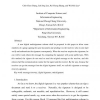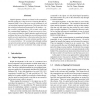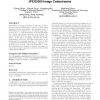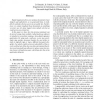AINA
2004
IEEE
14 years 4 months ago
2004
IEEE
With the explosion of the mobile communication market, more and more handheld devices act as clients in the Internet. People use these devices to purchase books, play games, recei...
ACSC
2004
IEEE
14 years 4 months ago
2004
IEEE
One of the primary flaws with current digital signature technology is that a digital signature does not "feel" or resemble a traditional seal or personal signature to th...
ACNS
2004
Springer
14 years 4 months ago
2004
Springer
Motivated by the conflict between authenticity and privacy in the digital signature, the notion of limited verifier signature was introduced [1]. The signature can be verified by a...
PQCRYPTO
2010
14 years 4 months ago
2010
A New digital signature scheme based on Stepwise Triangular Scheme (STS) is proposed. The proposed trapdoor has resolved the vulnerability of STS and secure against both Gr¨obner ...
PKC
1998
Springer
14 years 5 months ago
1998
Springer
A new digital multisignature scheme shall be proposed in this paper to allow some members of a group signing the same document and sending it to the receiver, who in turn shall ve...
ACSAC
2000
IEEE
14 years 5 months ago
2000
IEEE
Digital signature schemes are based on the assumption that the signing key is kept in secret. Ensuring that this assumption holds is one of the most crucial problems for all curre...
HICSS
2002
IEEE
14 years 5 months ago
2002
IEEE
This research paper presents a new system's design and development of the prescription order communication system (POCS) based on the Internet between the hospital and the ph...
MM
2003
ACM
14 years 6 months ago
2003
ACM
JPEG2000 is an emerging standard for still image compression and is becoming the solution of choice for many digital imaging fields and applications. An important aspect of JPEG2...
WETICE
2003
IEEE
14 years 6 months ago
2003
IEEE
Digital signatures, like physical signatures, can verify that a specific user affixed their signature to a document and they can also verify that the document is the same as when ...
ACSAC
2003
IEEE
14 years 6 months ago
2003
IEEE
Digital signatures allow us to produce documents whose integrity and authenticity, as we generated them, is verifiable by anybody who has access to our public key. Furthermore, w...




